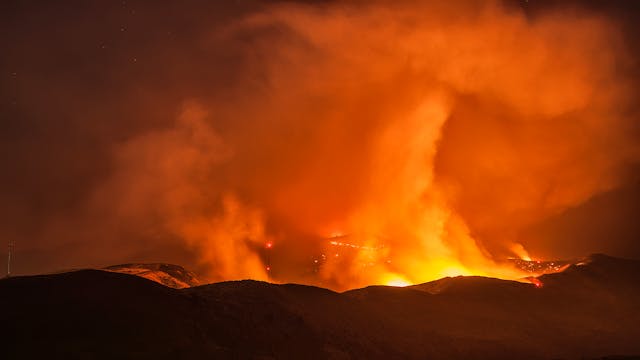
What causes a fire tornado? A fire tornado is caused when the intense heat from the fire rapidly warms the air above the ground and makes it rise in a spiral.
Fire tornadoes are fairly common, but it is very uncommon for someone to see them because you would need to be in the middle of a forest fire or some other kind of vast fire. If you search on YouTube, you can find examples of them. Fire tornadoes are also actually not tornadoes, which is why they have several different names. They are called fire whirls, fire devils, fire whirlwind, fire twister, and sometimes firenado. I am going to continue to call them fire tornadoes, though. Why are they not tornadoes? A tornado is a column of air that descends from a massive thunderstorm, while whirlwinds, waterspouts, and fire tornados rise up from the ground and don’t have to be associated with a thunderstorm, thus they are not really tornadoes. In a tornado, there is always a supercell thunderstorm, which is much bigger than a regular thunderstorm. Rising warm air and sinking cold air in the middle of the supercell make it rotate. As the supercell gets bigger, more warm air goes upwards and cold air comes out of the middle of the storm towards the ground. The warm moist air creates a spinning funnel in the middle and the cold sinking air pulls the funnel down to the ground, where it becomes a tornado.
Waterspouts and fire tornadoes form in a similar way and it is the exact opposite way to a tornado. A tornado is pulled down from the sky by the sinking cold air, but a waterspout and a fire tornado are pulled up from the ground by the rising warm air. In the case of a waterspout, the sun heats the surface of the sea and the air above it. The warm air rises up, carrying a lot of moisture with it because warm air has more energy, which means it can hold more water. This happens anywhere when the sun heats the sea but when there is a strong horizontal wind, a waterspout can form. The horizontal wind blows past the rising warm air and spins it. Once the waterspout has started to spin, the wind makes it go faster and a column of water is sucked up into the sky. Waterspouts are not as powerful as tornadoes, and they don’t last very long.
A fire tornado forms in the same way as a waterspout, but the ground is heated by the fire and not by the sun. This usually happens during a wildfire, although fire tornadoes occurred during the firebombing of German and Japanese cities during World War 2. Wildfires create their own wind and weather, which leads to the formation of fire tornadoes. The main principle is that warm air rises. When the fire starts, the center of the fire becomes very hot. The temperature can get over 1,000℃, which is almost hot enough to melt gold. The fire heats the air above it, which rises very quickly. When the air rises, it creates a vacuum where it was, which draws more cold air and fire into it. This air is then heated and rises, creating a circular effect. The air that is drawn into the fire brings in more oxygen, which makes the fire burn more fiercely and hotter, making more hot air rise. This rising hot air can cause clouds to form. The hot air carries a lot of ash and when it gets higher, it starts to cool down. The water it is carrying condenses on the ash and forms clouds called pyrocumulus, which means “fire cloud”. The fire clouds can become storms in their own right and there is often lightning, which can light even more fires. The whole system feeds itself and is incredibly difficult to extinguish. In the same way as a waterspout, the rising hot air from the center of the fire can get spun by the fast winds coming in to to fill the void where the air had been. When they spin the column of air, it sucks fire up with it, creating a rising fire tornado.
Owing to climate change, wildfires are becoming more common and there will be more fire tornadoes because they are a natural phenomenon. Wildfires are almost impossible to extinguish because they are too big and too hot. The only thing that firefighters can do is to try to cut fire gaps so that the fire can’t head towards towns or farms. This doesn’t always work and the wind that the fire creates can make the fire jump large gaps. The hot dry air above the fire dries out all of the vegetation, making it more flammable. And this is what I learned today.
Photo by Frank Cone: https://www.pexels.com/photo/eruption-of-volcano-18092546/
Sources
https://en.wikipedia.org/wiki/Fire_whirl
https://science.howstuffworks.com/nature/natural-disasters/fire-tornado.htm
https://en.wikipedia.org/wiki/Tornado
https://www.britannica.com/story/how-do-tornadoes-form
https://wfca.com/wildfire-articles/wildfire-temperatures-how-hot-can-wildfires-burn
https://blog.gov.bc.ca/bcwildfire/wildfire-tactics-what-it-takes-to-put-it-out

Pingback: #157 When did we start using fire extinguishers?